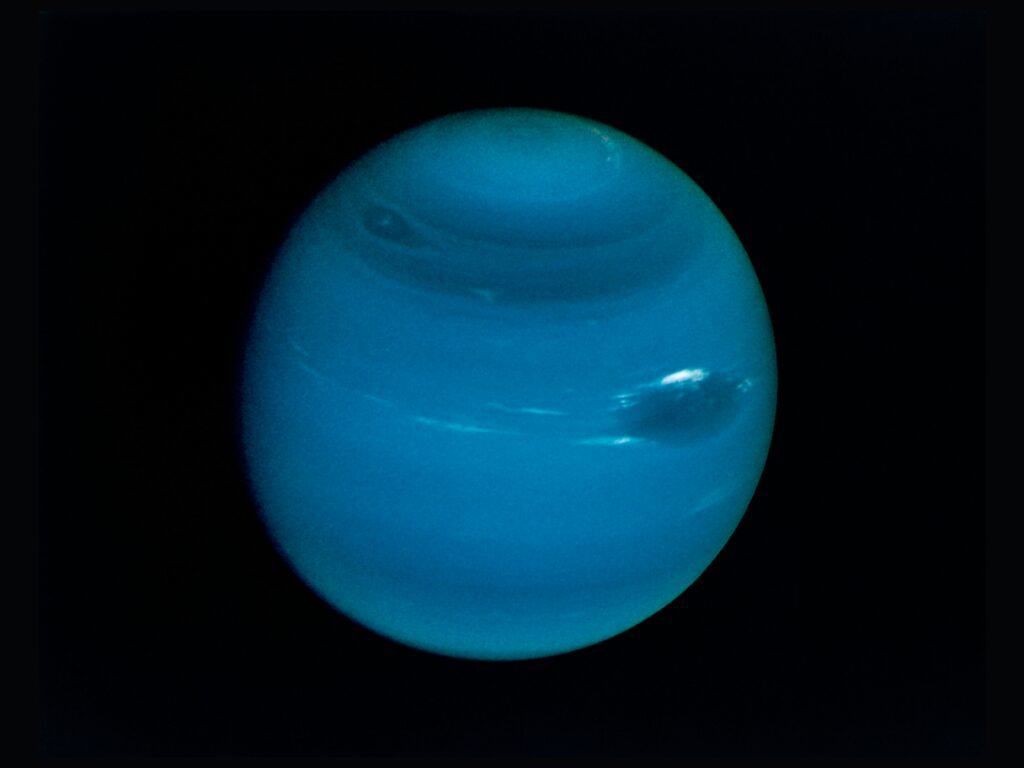Plus you can learn more about what’s in our Solar System with our Top 10 Facts on the Sun and the Moon; the planets Earth, Mercury, Venus, Mars, Jupiter, Saturn, Uranus and the dwarf planet Pluto.
Welcome to the amazing world of Neptune – the eighth planet from the Sun and the most distant planet from our Solar System. This beautiful blue planet is named after the Roman god of the sea and it has many fascinating features. Here are the top 10 facts about Neptune that you should know.
1. Neptune is the final planet in the Solar System.

Neptune is the seventh planet from the Sun in our Solar system. In the past it was the 2nd to last planet in the Solar System because of Pluto however Pluto is now considered a Dwarf planet.
2. Neptune is more than 30 times as far from the Sun as Earth.
Neptune is 4.4738 billion kilometres from the Sun.
3. A year on Neptune is equivalent to 164.81 Earth years.
Because Neptune is so far from the Sun, it takes a long time to orbit around it and complete its year. Since it take 164 Earth years to equal 1 Earth year you would never reach your birthday if you lived on Neptune.
4. Neptune is an ‘Ice Giant’.
Neptune is an ice giant. It’s made up of dense “icy” materials, mainly water, methane and ammonia – above a small rocky core.
Learn more about Space with Deep Space High below!
5. Neptune has at least 5 rings.
Neptune has at least five main rings and four more ring arcs, which are clumps of dust and rocks likely formed by the gravity of a nearby moon.
6. There are arguments over who discovered Neptune.

The first person to have seen Neptune was likely Galileo. In one of his drawings we see Neptune labelled as a star. However because he didn’t recognise that it was a planet he didn’t get credit for discovering it.
That credit goes to 2 mathematicians. French mathematician Urbain Le Verrier and the English mathematician John Couch Adams. They both predicted that a new planet – known as Planet X– would be discovered in a specific region of the sky.
When astronomer Johann Gottfried Galle actually found the planet in 1846, both mathematicians took credit for the discovery.
Who do you think should get credit for it’s discovery?
7. Neptune is named after the Roman God of the Sea.

The planet is named after the Roman god of the sea as suggested by French mathematician, Le Verrier, who is one of the people credited with discovering Neptune.
8. Neptune has 14 moons.
Neptune has 14 known moons. Neptune’s largest moon Triton was discovered on October 10, 1846, by William Lassell, just 17 days after Galle discovered the planet. What a month in science that must have been!
9. No humans have set foot on Neptune.
Voyager 2 is the only spacecraft to have visited Neptune and no humans were on board.
No spacecraft has orbited this distant planet to study it at length and up close, this is because it is so far away it is very hard to build something that can make such a big journey and stay around to do research.
10. Neptune is Blue because of methane.
Neptune is made up of methane – the same gas that makes up some of our trumps. The type of methane on Neptune gives it its blue colour.
Let’s keep learning with our Top 10 Facts about Space and Top 10 Facts about the Solar System. Plus you can learn more about what’s in our Solar System with our Top 10 Facts on the Sun and the Moon; the planets Earth, Mercury, Venus, Mars, Jupiter, Saturn, Uranus and the dwarf planet Pluto.
Send us your favourite facts!
Is there something we've missed? Got a fact you're dying to tell us? Submit it below and we could use it on a future Top 10 Facts page!
Remember to always ask an adult before filling out forms online.



